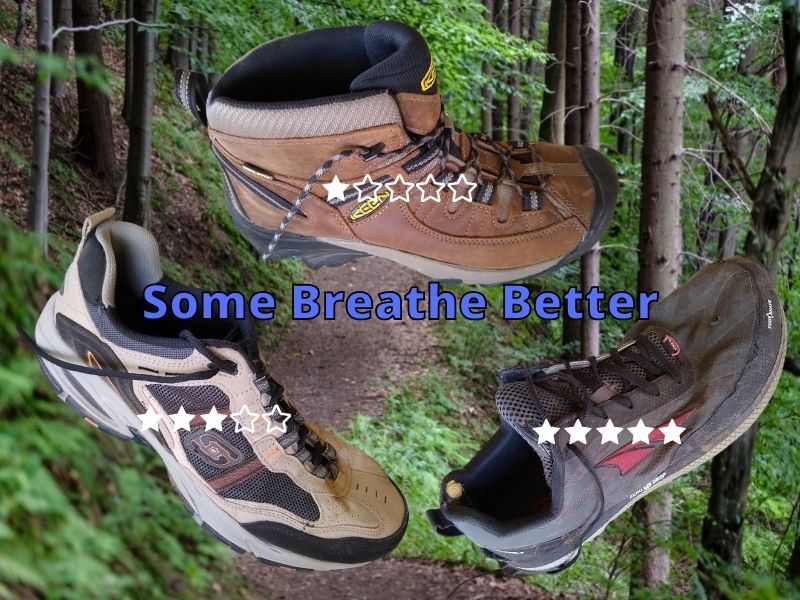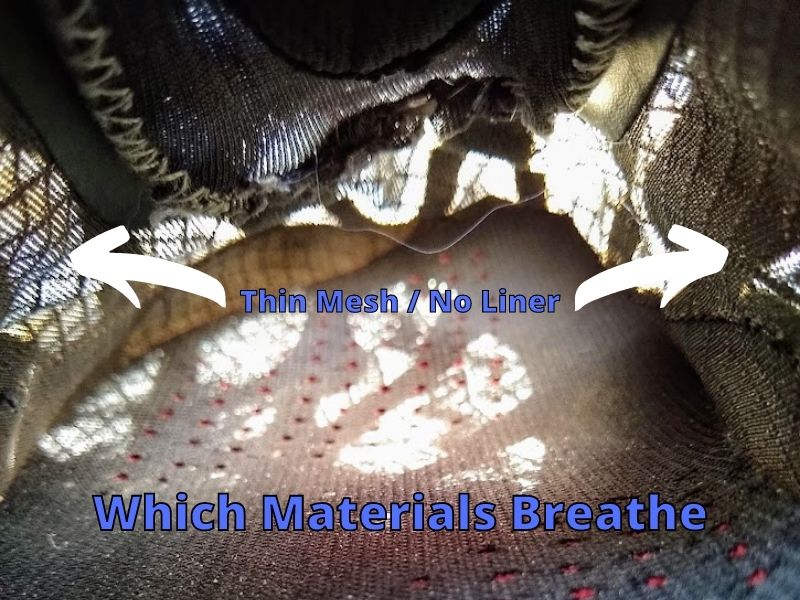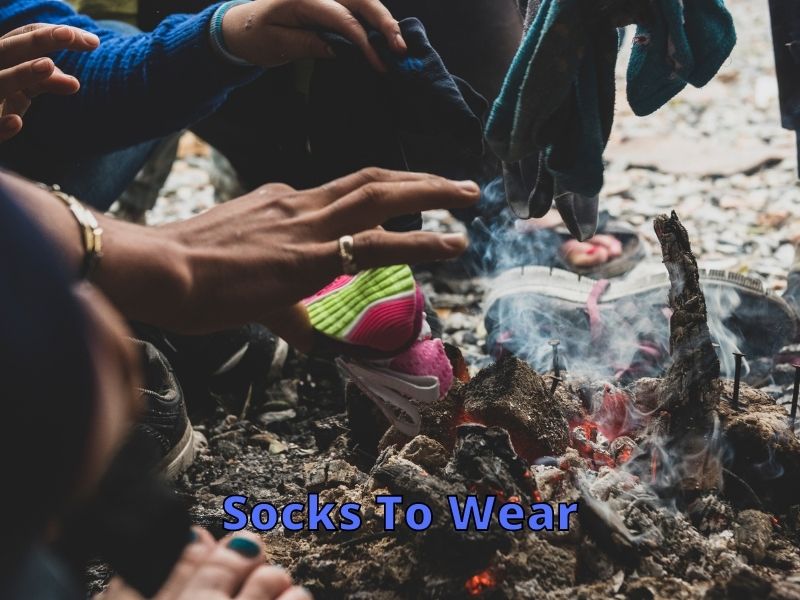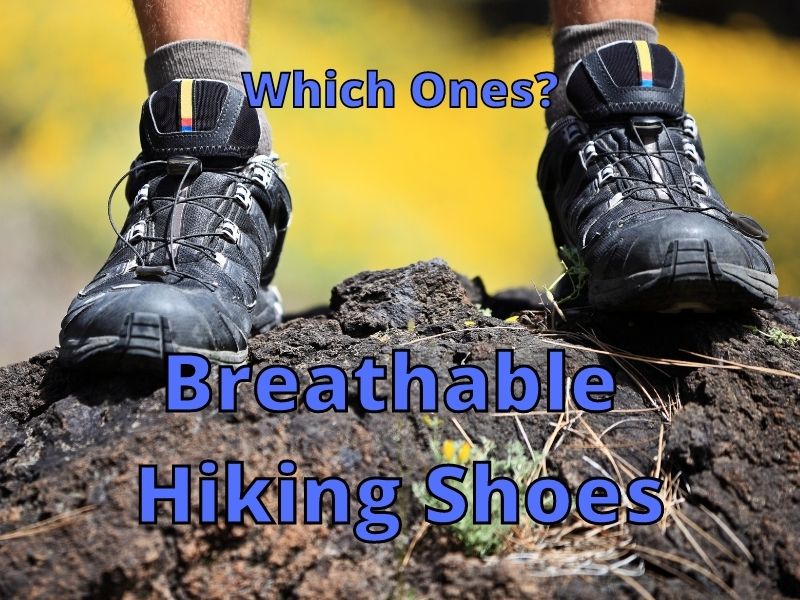I have used trail shoes for hiking, and they breathe very well, but I wouldn’t take them on a multi-day hiking trip. I would take my pair of lightweight mesh hiking shoes that breathe OK or my other pair of hiking boots that are waterproof but don’t breathe well.
I would use each of these shoes in different situations, but I would likely choose my trail shoes if I need ones that breathe well.
Shoes that breathe well have thin material and lots of mesh. Many trail running shoes and many lightweight hiking shoes have lots of mesh and thinner materials. Some waterproof shoes can breathe, but usually not very well.
It’s nice if you are able to have more than one hiking shoe, but if you only have one option, which type of hiking shoe would breathe well and perform best? Continue reading to find out the test that I did and which hiking shoe is best for you.
Which Hiking Shoes Breathe Well?

On hot days, it’s helpful to have breathable hiking shoes. Even on cold days, a breathable hiking shoe might be what you prefer.
Breathable hiking shoes help release moisture from inside hiking shoes so your feet can stay dry. Dry feet are very important when hiking. Hiking often causes blisters and one of the main reasons is too much moisture. (see article)
When you’re looking to buy a hiking shoe, one area to inspect is the amount of mesh and the thickness of the material. This will help you determine if the shoe can breathe well.
Here is a list of 5 hiking shoes that can breathe well.
1. Danner Men’s Trailcomber 3″ Hiking Shoe
This shoe is made with lightweight materials and people find that it is very comfortable. Reviews love how breathable it is and it is a great shoe for those who need the feet to breathe.
Details
- Extremely Breathable Mesh With TPU Overlay
- Uses Lightweight Materials
2. Astral Men’s TR1 Mesh Minimalist Hiking Shoe
This trail shoe dries quickly because it has lots of mesh surrounding the shoe. It also has drain holes so when you cross a stream, the water can drain out quickly. The mesh has some TPU overlays for durability but that shouldn’t interrupt the shoe’s ability to breathe.
Details
- Breathable Mesh With TPU Overlay
- Uses Lightweight Materials
3. Salewa Ultra Train 3
This trail shoe is similar to the Altra Superior 3.5 shoes that I have. They don’t have a liner. They have mesh uppers with a TPU overlay so your feet can breathe, and the shoe remains fairly rugged. People love this shoe because when they go for a hike, it breathes extremely well.
Details
- Extremely Breathable Mesh Upper With TPU Overlay
- Uses Lightweight Materials
4. Merrell All Out Blaze Aero Sport
This trail shoe is lightweight and has lots of mesh. People are surprised that it dries quickly after getting wet. It has polyurethane-coated leather and a mesh upper. It weighs about 11.3 oz for a men’s size and 10 oz. for a women’s size.
Details
- Extremely Breathable Mesh Upper
- Mesh Fabric With TPU Overlay
- Uses Lightweight Materials
5. Astral Brewer 2.0
This hiking shoe is lightweight and dries quickly. The upper seems to be made of canvas and mesh, which makes it a great shoe for hiking in water because it dries so fast. Its outsole is fairly grippy, so it won’t slip much when hiking.
Details
- Breathable Upper Dries Quickly
- Mesh Fabric With Canvas
- Uses Lightweight Materials
Why Choose Thin Upper Material
When I go hiking in my trail running shoes, the uppers are so thin that they stay dry even if my feet are sweaty. Having a lightweight shoe with lots of mesh can help moisture escape, so it doesn’t get trapped like some hiking boots have a problem with.
In some shoes, the upper materials are thick, and some have a breathable waterproof membrane, but if any moisture gets in the shoe, they take forever to dry out.
So to repeat myself, if you go hiking and it is hot, even if you have your wool socks on to move moisture away from your feet, your feet might start to get moist and begin to rub, causing blisters.
This happens because the moisture or accumulated sweat from your feet can’t escape if you’re wearing a hiking shoe with thick upper materials or it has a waterproof membrane.
Choose An Upper With No Lining
The best shoes to help your feet stay dry are those with thin material, those that have lots of mesh, and those without lining on the inside.
Lining can trap some of the moisture that occurs when you cross a stream or sweat during your hike. So I would look for a shoe that has little to no lining when choosing mine.
Waterproof Shoe vs Non-Waterproof Shoe Breathability

Waterproof Hiking Shoes
Sometimes, buying a waterproof shoe is a good choice when hiking. These shoes come in handy when you are hiking in the rain or if you are crossing streams that are only a couple of inches deep.
Although pretty much all waterproof hiking shoes don’t breathe well. Many waterproof hiking shoes have a breathable waterproof membrane, but they just can’t let go of the moisture quickly enough to make a difference.
Hikers will tell you that once water gets in their waterproof hiking shoes, it tends to stay there the rest of the day and sometimes into the next day. These shoes are not meant to dry quickly, so you have to weigh the pros and cons of using these types of hiking shoes.
I have a pair of Keen Targhee 2 hiking boots that are waterproof. They hold on to moisture for a long time if they get wet on the inside. The benefit of using these shoes is when you go on a long-distance hike; they help support your feet so they don’t have to do so much work.
If you’re not hiking through deep streams or heavy rainfall, then these boots can be helpful. Hiking shoes like these do well in cooler weather and work well when going on a trek for several days.
When you get a waterproof shoe, it can’t breathe very well because of the added membrane. On a hot, that can make a big difference in how hot your feet get and how much moisture is accumulated. (switchbacktravel.com)
Non-Waterproof Hiking Shoes
The great thing about many non-waterproof shoes is they can breathe much better than waterproof shoes can. It all depends on the thickness of the upper material and how breathable the material is.
The best material for breathability is mesh. Mesh comes in different forms but generally lets your feet have plenty of airflow.
Some mesh looks like a screen, while others look like a checkerboard or grid pattern. Mesh lets air in and moisture escape easily. That’s why many hiking shoes that have thin mesh material uppers are called water hiking shoes.
These water hiking shoes can dry extremely quickly after you get them wet.
So, if you are looking to buy non-waterproof hiking shoes, here are some of the things you want to look for in a breathable shoe.
- Thin upper material
- No internal liner
- Lots of mesh
- Quick drying materials
- Water drain holes
Waterproof vs Non-waterproof Hiking Shoes Pro and Cons
Pros of Waterproof Hiking Shoes
- They keep feet dry from rain
- They allow you to cross shallow streams and not get wet
- Many support your feet well for long-distance hikes
- Many are made with rugged materials so they last a long time
Pros of Non-waterproof Hiking Shoes
- They dry quickly
- They are usually lightweight
- They let your feet breathe on hot days
- They come in many varieties of cushioning, so some can accommodate longer hikes for experienced hikers.
There are pros and cons to each type of hiking shoe. What will work best for you depends on the circumstances (see video). But, if you need a breathable hiking shoe, always get one that is not waterproof.
Which Materials Help Hiking Shoes Breathe Best?

The first thing you need to look for is how thin the upper is. Thin material will almost always breathe well unless it is completely covered in a layer of TPU (Thermoplastic Polyurethane – it resembles a rubber-like plastic.)
Look for thinner fabrics that have a mesh pattern. Some are less visible, so you might need to look closely at the fabric to tell how breathable the fabric is and if it is mesh-like.
Hiking shoes with a lot of mesh will increase moisture transfer and airflow through your shoe, enabling better evaporation of water and perspiration.
So, the more mesh on your shoes and the thinner the liner inside the shoe, the better breathability you will have. If you get a shoe with no liner that is even better. (see photo below) You can see how
Remember that hiking boots and some shoes will have lots of material that can soak up moisture. Shoes with lots of leather or thick materials will hold water for a long time.
So, choose your hiking shoe material with these facts in mind. Here’s a video about my hiking shoes and how breathable they are.
Should I Wear Breathable Hiking Shoes In Cold Or Rainy Weather?
In The Cold
When hiking for longer periods with heavier packs, it’s a good idea to use more rigid hiking shoes. These often have thicker material and weigh more. They usually don’t breathe well but can keep your feet warmer in cold weather.
How cold is it? When hiking through the snow for longer than 15-30 minutes, you will likely need a heavier hiking shoe. Waterproof shoes could work well in these situations.
Yet, you don’t always need to wear heavy hiking boots when hiking for long periods or in the cold. One option is to double up on the layers of socks you are wearing.
Thicker and warmer socks do a good job of keeping your feet warm, even if you are wearing trail running shoes.
The important thing to be aware of is the weight of your pack. Heavy packs will impact your feet over long distances. If you can, reduce your pack weight when wearing lighter-weight hiking shoes.
In The Rain
When you expect the weather to be mostly rainy when you go hiking, you will need to consider several factors. These include:
- How hard is it raining – If it’s raining too hard, rain will likely get in your hiking shoes regardless of whether they are waterproof or not.
- Will you be walking through the mud? – Mud can cover the entire surface of a trail running shoe easily. But it can wash off and dry easily too. A taller hiking boot may work well in the mud, especially if you’re in the mud for long distances.
- Light rain – If the rain isn’t hard, a waterproof shoe works well. However, many hikers prefer a lighter hiking shoe that is breathable, even in light rain, because they dry quickly. The important thing to consider is if it will be raining the entire hiking trip, then waterproof hiking shoes might be your best bet.
Which Sock Are Best To Use With Breathable Shoes vs Non-Breathalbe Shoes?

The socks you wear can make a big difference when you go hiking. Hiking socks will wick moisture away from your feet, helping to keep them dry.
If you wear breathable hiking shoes, then I feel the best socks to wear are wool blend hiking socks. These socks help wick moisture from your feet and then release the moisture well.
If you wear non-breathable hiking shoes, then I also feel the best socks to wear are wool blend hiking socks. The reason for this is that wool can soak up a lot of moisture, better than almost any other kind of sock, and this will help keep your feet dry so you won’t get blisters.
Then after your hiking day is done, you can hang your socks to dry, so they’ll be ready for the next day and your non-breathable shoes shouldn’t be wet inside.
The only time I would be worried is if it’s a hot day and you’re sweating a lot, then you might want to switch socks in the middle of your hike to keep your feet dry.
If you are planning to go through streams and you know your feet will get wet, then get a thin hiking sock. You can go for a thin wool blend sock or another thin hiking sock that dries quickly and wicks moisture well.
See my article on socks to wear when it’s hot to find some good breathable socks.
Final Thoughts
There are lots of shoes to choose from when looking for breathable hiking shoes. Depending on you where you hike, how long you will be hiking for, and the weather you normally hike in will help you determine if and what kind of breathable hiking shoe you should get.
I feel that if you search for a good breathable hiking shoe, it could work out in most hiking situations that you find yourself in.
Thanks for visiting Helpshoe.com






